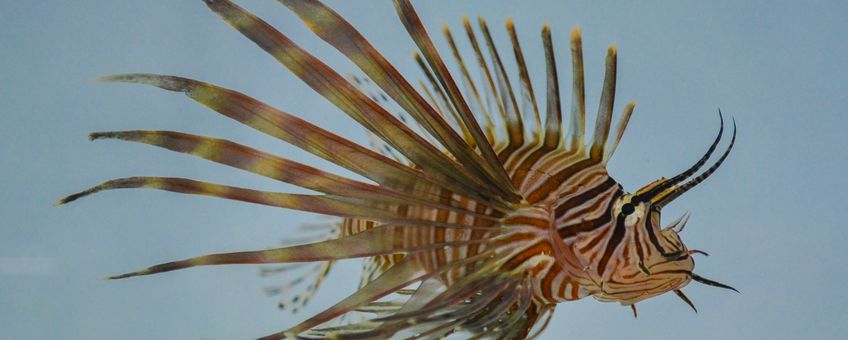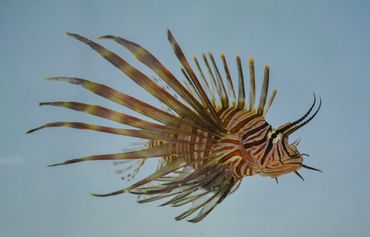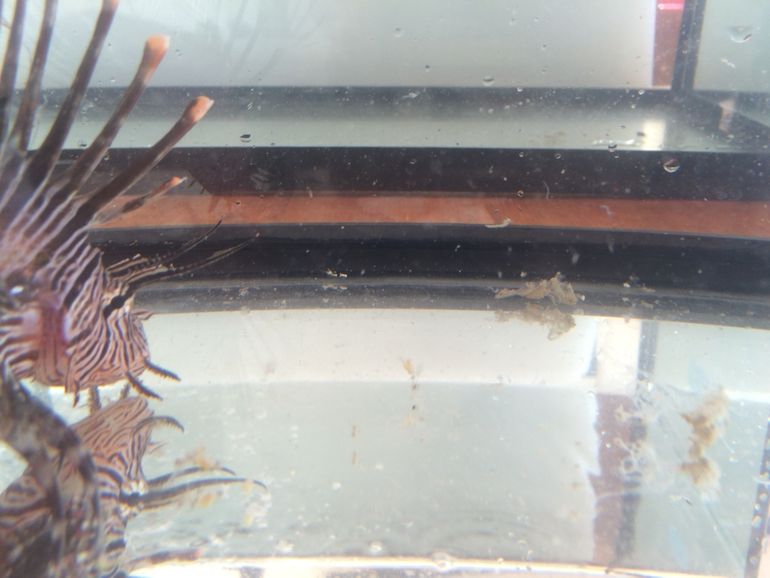
Environmental DNA as a tool for lionfish mapping
Dutch Caribbean Nature Alliance (DCNA), Indiana UniversityLionfish invasion
When a new species is introduced to a foreign environment, it can upset the natural balance. One such example is the introduction of the Pacific Red Lionfish (Pterois volitans) into the Atlantic Ocean during the 1980s. Lionfish can reproduce very quickly, with an individual female laying approximately 2 million eggs per year. The combination of high reproduction rates and a lack of natural predators led this species to populate quickly and spread rapidly throughout the Caribbean Sea.
Lionfish have a seemingly insatiable appetite, capable of consuming up to twenty reef fish within thirty minutes. There have been cases where up to 80 percent of local fish populations were consumed by invading lionfish. This large appetite is destructive to the reef in other ways as well: they consume a significant number of algae eating fish. Without these fish to keep local algae under control, algae can spread, choking out native coral populations.
Historically, marine parks have relied on visual surveys to track lionfish numbers and population shifts. This requires a significant investment in both time and money, as lionfish can be hard to spot because they often hide within the coral structures during the day. Fortunately, a new technique using environmental DNA (eDNA) is emerging. It has the potential to reduce the time, money and labor required to conduct lionfish surveys. All living organisms leave DNA evidence in their environment (through hair, scales, excrement et cetera). This means that if scientists are able to detect this DNA, it’s possible to have a comprehensive list of each species living within an area. This is known as environmental DNA (eDNA), and scientists are getting progressively better at mapping and reading these samples.
eDNA Research on Bonaire
Researchers from Indiana University and CIEE Bonaire completed a series of studies to apply eDNA sampling techniques within the waters of Bonaire. During these controlled laboratory experiments, scientists worked to better understand if eDNA detection strength was related to the number of lionfish present. They hypothesized that the more lionfish are present within an area, the stronger the eDNA signal would be, even as fish density was held constant. There was also a question concerning the amount of time after a lionfish had left an area, its eDNA would be detectable. To complete these tests, laboratory environments were set up to mimic conditions similar to waters around Bonaire. These tests found that eDNA strength does directly correlate to the number of lionfish present. Therefore, a stronger signal could indicate the presence of multiple lionfish within a particular area. However, distance and time are still important covariates that could mask or enhance signal strength: therefore, more research is needed. This study also found that eDNA was detectable up to 48 hours after a lionfish had been removed. Knowing this expiration data on eDNA is critical to understand when an organism was present in that area.
Once the laboratory portion of the experiments was completed, a field study was conducted to validate these findings within the lionfish’s habitat. This experiment found, amongst others, that traces of lionfish eDNA could be detected both on the surface and at the bottom with similar strengths. Knowing that lionfish eDNA signals can be detected with similar strengths throughout the water column is very important, as this means sampling can be conducted at the sea surface, removing the need for divers. This also means that more samples can be collected within a shorter period of time, allowing larger regions to be patrolled for lionfish. Furthermore, knowing the length of time it takes for eDNA to break down (48 hours), the high sensitivity of detecting eDNA and the speed of the current at your sight of interest, one can predict the detection distance of eDNA for any aquatic species of interest.
The future of eDNA Research
 This study illustrates the important role that eDNA could play in the future of environmental monitoring. The results of this study show that this new technique allows researchers to detect rare or difficult to find species in conditions where visual observation falls short. eDNA sampling techniques could prove to be a game changer in understanding species composition of local environments. The processing of samples in this study costs approximately $0.05 per sample for a standard laboratory to collect and process. If these samples can be taken using surface water, this saves even more time and reduces risk to researchers, having eliminated the need for diving. This is especially important in areas which could be hazardous or difficult to sample. The ability to detect multiple species out of a single sample could allow scientists to gain insight into rare or difficult to find species. The possibilities of this application to conservation biology and environmental monitoring are very exciting.
This study illustrates the important role that eDNA could play in the future of environmental monitoring. The results of this study show that this new technique allows researchers to detect rare or difficult to find species in conditions where visual observation falls short. eDNA sampling techniques could prove to be a game changer in understanding species composition of local environments. The processing of samples in this study costs approximately $0.05 per sample for a standard laboratory to collect and process. If these samples can be taken using surface water, this saves even more time and reduces risk to researchers, having eliminated the need for diving. This is especially important in areas which could be hazardous or difficult to sample. The ability to detect multiple species out of a single sample could allow scientists to gain insight into rare or difficult to find species. The possibilities of this application to conservation biology and environmental monitoring are very exciting.
More information can be found in: Using Environmental DNA (eDNA) to Improve the Accuracy and Efficiency of Managing the Invasive Pacific Red Lionfish in the Carribean.
Text: Stephen Glaholt, Indiana University and Jessica Johnson & Tineke van Bussel, DCNA
Photos: Martijn Koot; Haley Erickson

